Monitoring Seasonal Growth of Eucalyptus Plantation under Different Forest Age and Slopes Based on Multi-Temporal UAV Stereo Images
Abstract
:1. Introduction
2. Materials and Methods
2.1. Study Area
2.2. Data Introduction
2.2.1. Field Data
2.2.2. UAV Data
2.3. Method
2.3.1. UAV Data Processing
2.3.2. Individual Tree Crown Segmentation
2.3.3. Extraction of Individual Eucalyptus Tree Structural Parameters
2.3.4. Extraction of Seasonal Growth in Structural Parameters of Individual Eucalyptus Trees under Different Forest Ages and Slopes
3. Results
3.1. UAV Data Processing Results
3.2. Results of Individual Tree Segmentation
3.3. Results of Individual Tree Structural Parameter Extraction
- (1)
- Results of Individual Tree Structural Parameter Extraction
- (2)
- Extraction Results of Individual Structural Parameters for Eucalyptus Across Different Forest Ages
3.4. Seasonal Growth Results of Individual Eucalyptus Structural Parameters under Different Forest Ages and Slope Conditions
- (1)
- The Seasonal Growth Results of Individual Tree Structural Parameters in Eucalyptus Plantations with Different Forest Ages
- (2)
- The Seasonal Growth Results of Individual Tree Structural Parameters in Eucalyptus Plantations under Different Slopes
4. Discussion
4.1. Analysis of Individual Tree Structure Parameter Extraction Results from UAV-RGB Images
4.2. Analysis of Growth Differences in Eucalyptus Plantations in Different Seasons
4.3. Analysis of Growth Differences in Eucalyptus Plantations at Different Forest Ages
4.4. Analysis of Growth Differences in Eucalyptus Plantations in Different Slope
5. Conclusions
- (1)
- Based on UAV images, it is possible to achieve high-precision extraction of structural parameters of individual trees in Eucalyptus plantations, with an extraction accuracy of R2 = 0.99, RMSE = 0.21 m for individual tree height, an extraction accuracy of R2 = 0.78, RMSE = 0.16 m for crown width, an extraction accuracy of R2 = 0.75, RMSE = 1.17 cm for DBH, and an extraction accuracy of R2 = 0.92, RMSE = 3.79 kg/tree for AGB.
- (2)
- The growth changes in the structural parameters of individual Eucalyptus trees vary in different seasons, with faster growth in spring and autumn and slower growth in summer and winter. The growth of tree height, crown width, DBH, and AGB in spring and autumn account for 76.39%, 73.75%, 73.65%, and 73.68% of the total annual growth, respectively.
- (3)
- The growth of different structural parameters of individual Eucalyptus trees is closely related to forest age. The growth of tree height, crown width, and DBH gradually slows down with increasing forest age, while AGB shows a trend of first increasing, and then decreasing. When the forest age is one-year-old, the growth change in AGB is the fastest.
- (4)
- The terrain has a certain impact on the growth of structural parameters of individual Eucalyptus trees. For Eucalyptus trees of one and three-years-old, Eucalyptus trees located on gentle slopes in spring and autumn grow faster than those on flat land. However, in summer and winter, Eucalyptus trees on flat land grow faster than those on gentle slopes. For Eucalyptus trees of one-month-old, Eucalyptus trees on gentle slopes grow faster than those on flat land in any season. For individual tree height, crown width, DBH, and AGB, the maximum annual growth differences between Eucalyptus trees on gentle slopes and flat land are 3.17 m, 0.26 m, 1.9 cm, and 9.27 kg/plant, respectively.
Author Contributions
Funding
Data Availability Statement
Conflicts of Interest
References
- Silverio, F.O.; Barbosa, L.C.; Maltha, C.R.; Silvestre, A.J.; Pilo-Veloso, D.; Gomide, J.L. Characterization of lipophilic wood extractives from clones of Eucalyptus urograndis cultivate in Brazil. BioResources 2007, 2, 157–168. [Google Scholar] [CrossRef]
- Dai, E.F.; Wang, X.L.; Zhu, J.J.; Xi, W.M. Quantifying ecosystem service trade-offs for plantation forest management to benefit provisioning and regulating services. Ecol. Evol. 2017, 7, 7807–7821. [Google Scholar] [CrossRef] [PubMed]
- Palma, J.; Hakamada, R.; Moreira, G.G.; Nobre, S.; Rodriguez, L.C.E. Using 3PG to assess climate change impacts on management plan optimization of Eucalyptus plantations. A case study in Southern Brazil. Sci. Rep. 2021, 11, 2708. [Google Scholar] [CrossRef]
- Farias, A.A.; Soares, C.P.B.; Leite, H.G.; da Silva, G.F. Quantile regression: Prediction of growth and yield for a Eucalyptus plantation in northeast Brazil. Eur. J. For. Res. 2021, 140, 983–989. [Google Scholar] [CrossRef]
- Zhang, Y.; Wang, X. Geographical spatial distribution and productivity dynamic change of Eucalyptus plantations in China. Sci. Rep. 2021, 11, 19764. [Google Scholar] [CrossRef]
- Maltamo, M.; Næsset, E.; Vauhkonen, J. Forestry Applications of Airborne Laser Scanning; Managing Forest Ecosystems; Springer: Dordrecht, The Netherlands, 2014; Volume 27, p. 460. [Google Scholar]
- Naesset, E. Estimating timber volume of forest stands using airborne laser scanner data. Remote Sens. Environ. 1997, 61, 246–253. [Google Scholar] [CrossRef]
- Hyyppä, J.; Hyyppä, H.; Leckie, D.; Gougeon, F.; Yu, X.; Maltamo, M. Review of methods of small-footprint airborne laser scanning for extracting forest inventory data in boreal forests. Int. J. Remote Sens. 2008, 29, 1339–1366. [Google Scholar] [CrossRef]
- Van Leeuwen, M.; Nieuwenhuis, M. Retrieval of forest structural parameters using LiDAR remote sensing. Eur. J. For. Res. 2010, 129, 749–770. [Google Scholar] [CrossRef]
- Nelson, R.; Krabill, W.; Tonelli, J. Estimating forest biomass and volume using airborne laser data. Remote Sens. Environ. 1988, 24, 247–267. [Google Scholar] [CrossRef]
- Nilsson, M. Estimation of tree heights and stand volume using an airborne lidar system. Remote Sens. Environ. 1996, 56, 1–7. [Google Scholar] [CrossRef]
- Leite, R.V.; Amaral, C.H.D.; Pires, R.d.P.; Silva, C.A.; Soares, C.P.B.; Macedo, R.P.; Silva, A.A.L.d.; Broadbent, E.N.; Mohan, M.; Leite, H.G. Estimating Stem Volume in Eucalyptus Plantations Using Airborne LiDAR: A Comparison of Area- and Individual Tree-Based Approaches. Remote Sens. 2020, 12, 1513. [Google Scholar] [CrossRef]
- Hu, L.; Xu, X.; Wang, J.; Xu, H. Individual tree crown width detection from unmanned aerial vehicle images using a revised local transect method. Ecol. Inform. 2023, 75, 102086. [Google Scholar] [CrossRef]
- Dong, C.; Cai, C.; Chen, S.; Xu, H.; Yang, L.; Ji, J.; Huang, S.; Hung, I.-K.; Weng, Y.; Lou, X. Crown Width Extraction of Metasequoia glyptostroboides Using Improved YOLOv7 Based on UAV Images. Drones 2023, 7, 336. [Google Scholar] [CrossRef]
- You, H.; Tang, X.; You, Q.; Liu, Y.; Chen, J.; Wang, F. Study on the Differences between the Extraction Results of the Structural Parameters of Individual Trees for Different Tree Species Based on UAV LiDAR and High-Resolution RGB Images. Drones 2023, 7, 317. [Google Scholar] [CrossRef]
- Iglhaut, J.; Cabo, C.; Puliti, S.; Piermattei, L.; O’Connor, J.; Rosette, J. Structure from motion photogrammetry in forestry: A review. Curr. For. Rep. 2019, 5, 155–168. [Google Scholar] [CrossRef]
- Pádua, L.; Hruška, J.; Bessa, J.; Adão, T.; Martins, L.M.; Gonçalves, J.A.; Peres, E.; Sousa, A.M.R.; Castro, J.P.; Sousa, J.J. Multi-Temporal Analysis of Forestry and Coastal Environments Using UASs. Remote Sens. 2018, 10, 24. [Google Scholar] [CrossRef]
- Chen, J.; Chen, Z.; Huang, R.; You, H.; Han, X.; Yue, T.; Zhou, G. The Effects of Spatial Resolution and Resampling on the Classification Accuracy of Wetland Vegetation Species and Ground Objects: A Study Based on High Spatial Resolution UAV Images. Drones 2023, 7, 61. [Google Scholar] [CrossRef]
- Krause, S.; Sanders, T.G.M.; Mund, J.-P.; Greve, K. UAV-Based Photogrammetric Tree Height Measurement for Intensive Forest Monitoring. Remote Sens. 2019, 11, 758. [Google Scholar] [CrossRef]
- Tang, X.; You, H.; Liu, Y.; You, Q.; Chen, J. Monitoring of Monthly Height Growth of Individual Trees in a Subtropical Mixed Plantation Using UAV Data. Remote Sens. 2023, 15, 326. [Google Scholar] [CrossRef]
- Chen, Q.; Baldocchi, D.; Gong, P.; Kelly, M. Isolating individual trees in a savanna woodland using small footprint lidar data. Photogramm. Eng. Remote Sens. 2006, 72, 923–932. [Google Scholar] [CrossRef]
- Miraki, M.; Sohrabi, H.; Fatehi, P.; Kneubuehler, M. Individual tree crown delineation from high-resolution UAV images in broadleaf forest. Ecol. Inform. 2021, 61, 101207. [Google Scholar] [CrossRef]
- Nuijten, R.J.; Coops, N.C.; Goodbody, T.R.; Pelletier, G. Examining the multi-seasonal consistency of individual tree segmentation on deciduous stands using digital aerial photogrammetry (DAP) and unmanned aerial systems (UAS). Remote Sens. 2019, 11, 739. [Google Scholar] [CrossRef]
- Panagiotidis, D.; Abdollahnejad, A.; Surový, P.; Chiteculo, V. Determining tree height and crown diameter from high-resolution UAV imagery. Int. J. Remote Sens. 2017, 38, 2392–2410. [Google Scholar] [CrossRef]
- Goldbergs, G.; Maier, S.W.; Levick, S.R.; Edwards, A. Efficiency of individual tree detection approaches based on light-weight and low-cost UAS imagery in Australian Savannas. Remote Sens. 2018, 10, 161. [Google Scholar] [CrossRef]
- Yin, D.; Wang, L. How to assess the accuracy of the individual tree-based forest inventory derived from remotely sensed data: A review. Int. J. Remote Sens. 2016, 37, 4521–4553. [Google Scholar] [CrossRef]
- The National Leading Group for Climate Change. Guidelines on Carbon Accounting and Monitoring for Forest Project: 2008. Available online: https://xueshu.baidu.com/usercenter/paper/show?paperid=f7e60bc546ba7c6be8e99b6c0aaa168d&site=xueshu_se (accessed on 1 November 2023).
- Dalla Corte, A.P.; Rex, F.E.; Almeida, D.R.A.d.; Sanquetta, C.R.; Silva, C.A.; Moura, M.M.; Wilkinson, B.; Zambrano, A.M.A.; Cunha Neto, E.M.d.; Veras, H.F.P.; et al. Measuring Individual Tree Diameter and Height Using GatorEye High-Density UAV-Lidar in an Integrated Crop-Livestock-Forest System. Remote Sens. 2020, 12, 863. [Google Scholar] [CrossRef]
- da Cunha Neto, E.M.; Rex, F.E.; Veras, H.F.P.; Moura, M.M.; Sanquetta, C.R.; Käfer, P.S.; Sanquetta, M.N.I.; Zambrano, A.M.A.; Broadbent, E.N.; Dalla Corte, A.P. Using high-density UAV-Lidar for deriving tree height of Araucaria Angustifolia in an Urban Atlantic Rain Forest. Urban For. Urban Green. 2021, 63, 127197. [Google Scholar] [CrossRef]
- Hao, Z.; Lin, L.; Post, C.J.; Jiang, Y.; Li, M.; Wei, N.; Yu, K.; Liu, J. Assessing tree height and density of a young forest using a consumer unmanned aerial vehicle (UAV). New Forest 2021, 52, 843–862. [Google Scholar] [CrossRef]
- Wiles, G.C.; Mennett, C.R.; Jarvis, S.K.; D’Arrigo, R.D.; Wiesenberg, N.; Lawson, D.E. Tree-ring investigations into changing climatic responses of yellow-cedar, Glacier Bay, Alaska. Can. J. For. Res. 2012, 42, 814–819. [Google Scholar] [CrossRef]
- Wang, Z.; Du, A.; Xu, Y.; Zhu, W.; Zhang, J. Factors Limiting the Growth of Eucalyptus and the Characteristics of Growth and Water Use under Water and Fertilizer Management in the Dry Season of Leizhou Peninsula, China. Agronomy 2019, 9, 590. [Google Scholar] [CrossRef]
- Stern, R.L.; Schaberg, P.G.; Rayback, S.A.; Hansen, C.F.; Murakami, P.F.; Hawley, G.J. Growth trends and environmental drivers of major tree species of the northern hardwood forest of eastern North America. J. For. Res. 2023, 34, 37–50. [Google Scholar] [CrossRef]
- Mokochinski, J.B.; Mazzafera, P.; Sawaya, A.C.H.F.; Mumm, R.; de Vos, R.C.H.; Hall, R.D. Metabolic responses of Eucalyptus species to different temperature regimes. J. Integr. Plant Biol. 2018, 60, 397–411. [Google Scholar] [CrossRef] [PubMed]
- Burkhart, H.E.; Tomé, M. Modeling Forest Trees and Stands; Springer Science & Business Media: Berlin/Heidelberg, Germany, 2012. [Google Scholar]
- West, P.; Ratkowsky, D. Problems with models assessing influences of tree size and inter-tree competitive processes on individual tree growth: A cautionary tale. J. For. Res. 2022, 33, 565–577. [Google Scholar] [CrossRef]
- Askne, J.I.H.; Persson, H.J.; Ulander, L.M.H. Biomass Growth from Multi-Temporal TanDEM-X Interferometric Synthetic Aperture Radar Observations of a Boreal Forest Site. Remote Sens. 2018, 10, 603. [Google Scholar] [CrossRef]
- Neeff, T.; dos Santos, J.R. A growth model for secondary forest in Central Amazonia. For. Ecol. Manag. 2005, 216, 270–282. [Google Scholar] [CrossRef]
- Matala, J.; Hynynen, J.; Miina, J.; Ojansuu, R.; Peltola, H.; Sievänen, R.; Väisänen, H.; Kellomäki, S. Comparison of a physiological model and a statistical model for prediction of growth and yield in boreal forests. Ecol. Model. 2003, 161, 95–116. [Google Scholar] [CrossRef]
- Kurz, W.A.; Stinson, G.; Rampley, G. Could increased boreal forest ecosystem productivity offset carbon losses from increased disturbances? Philos. Trans. R. Soc. B Biol. Sci. 2008, 363, 2259–2268. [Google Scholar] [CrossRef]

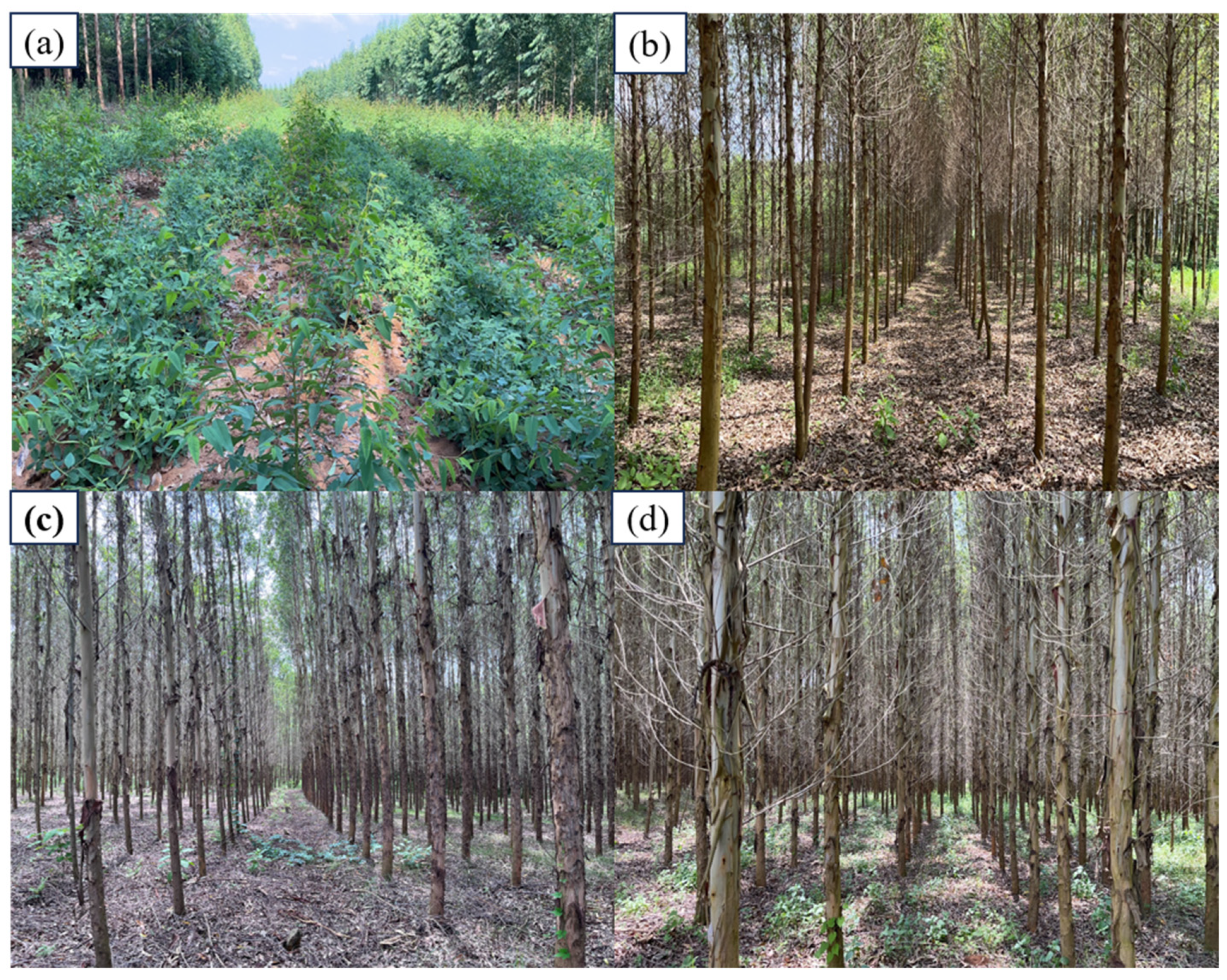

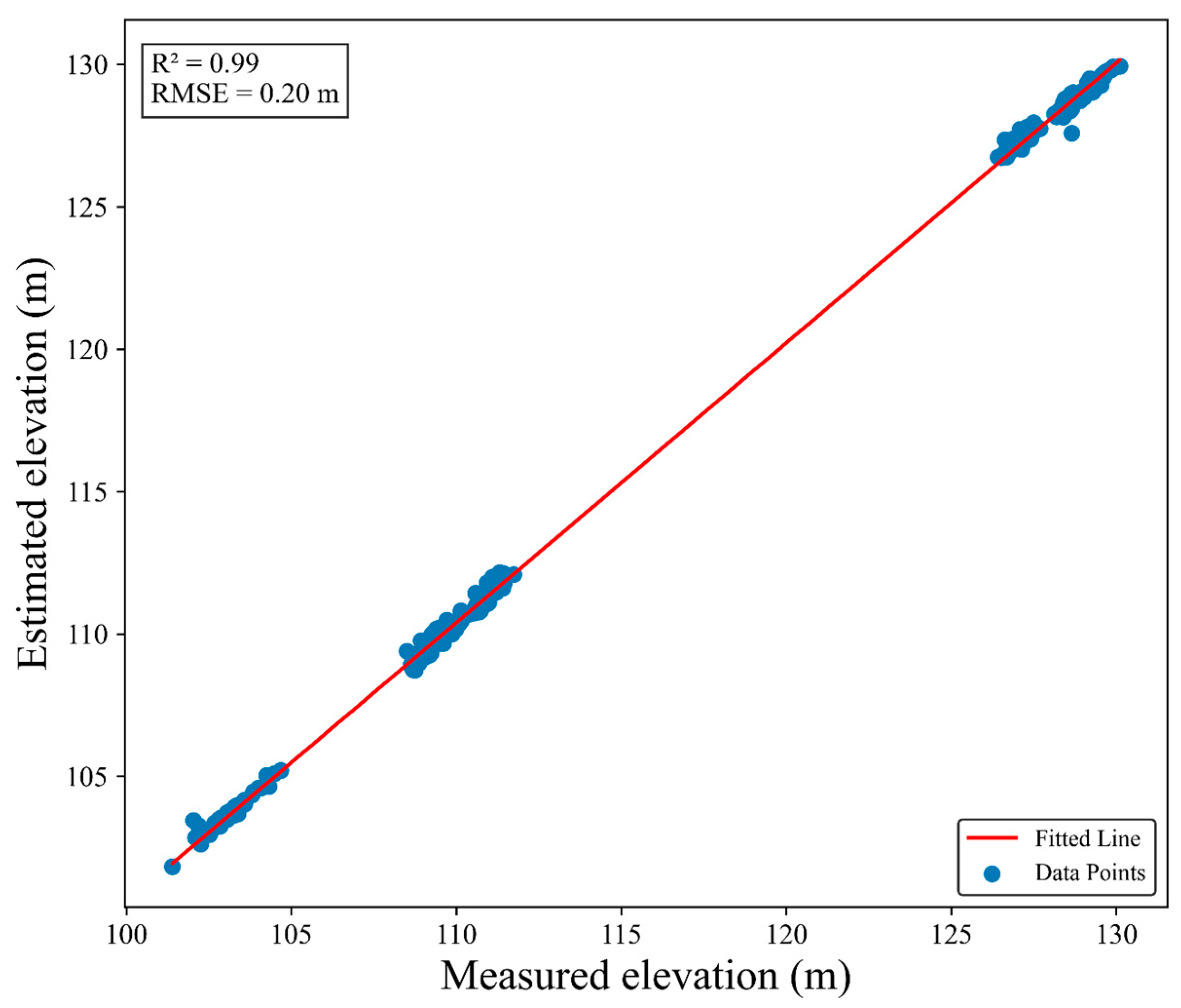
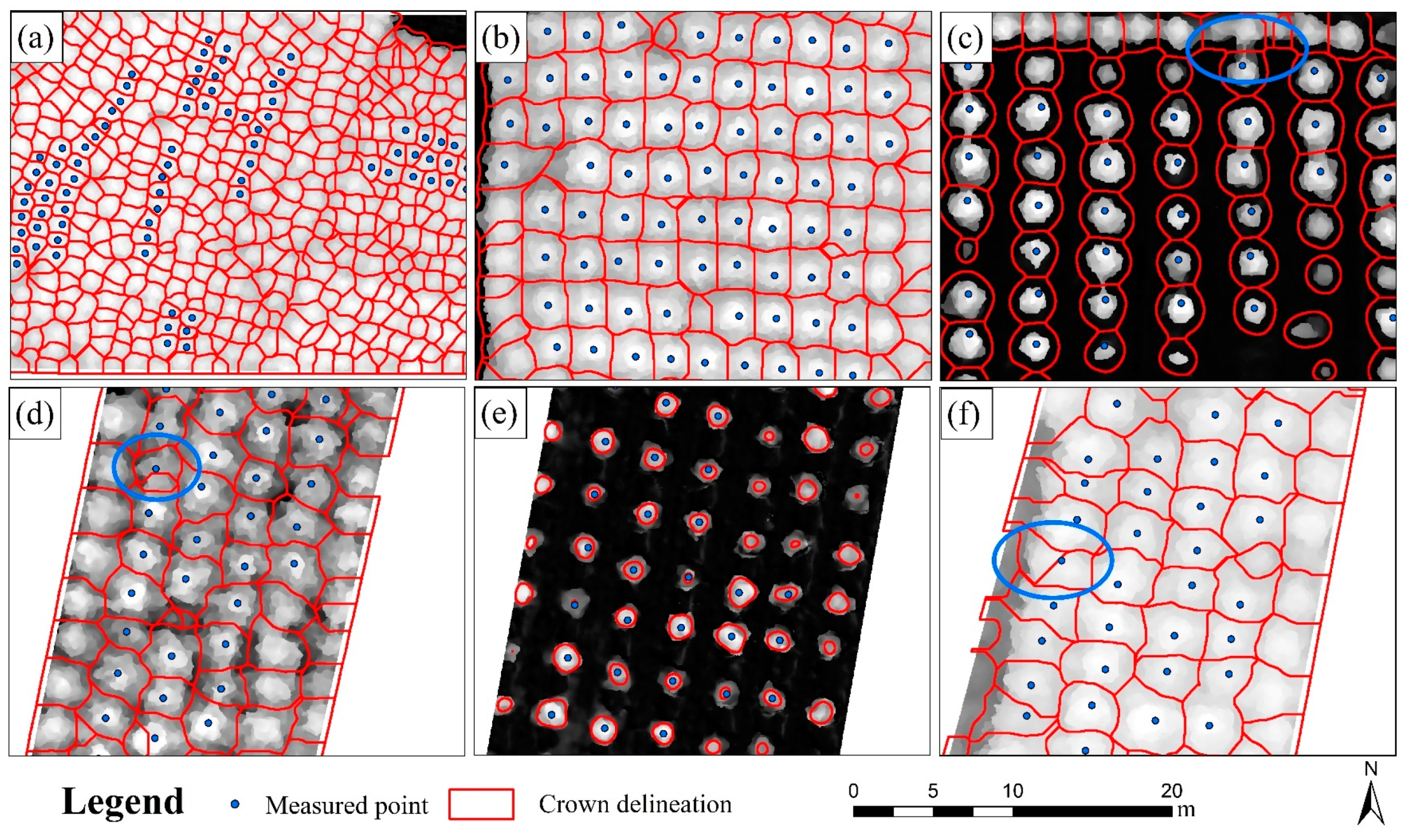
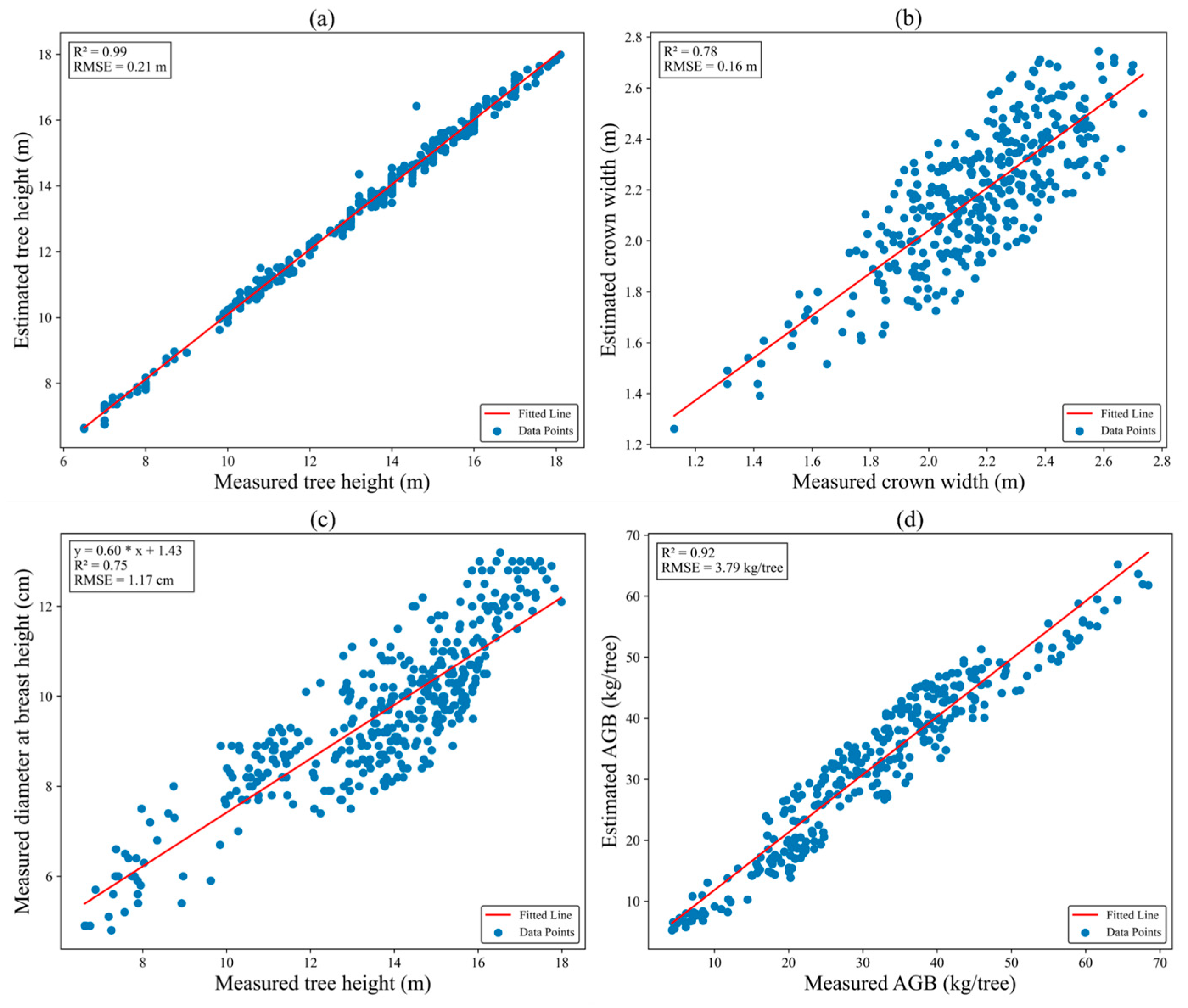

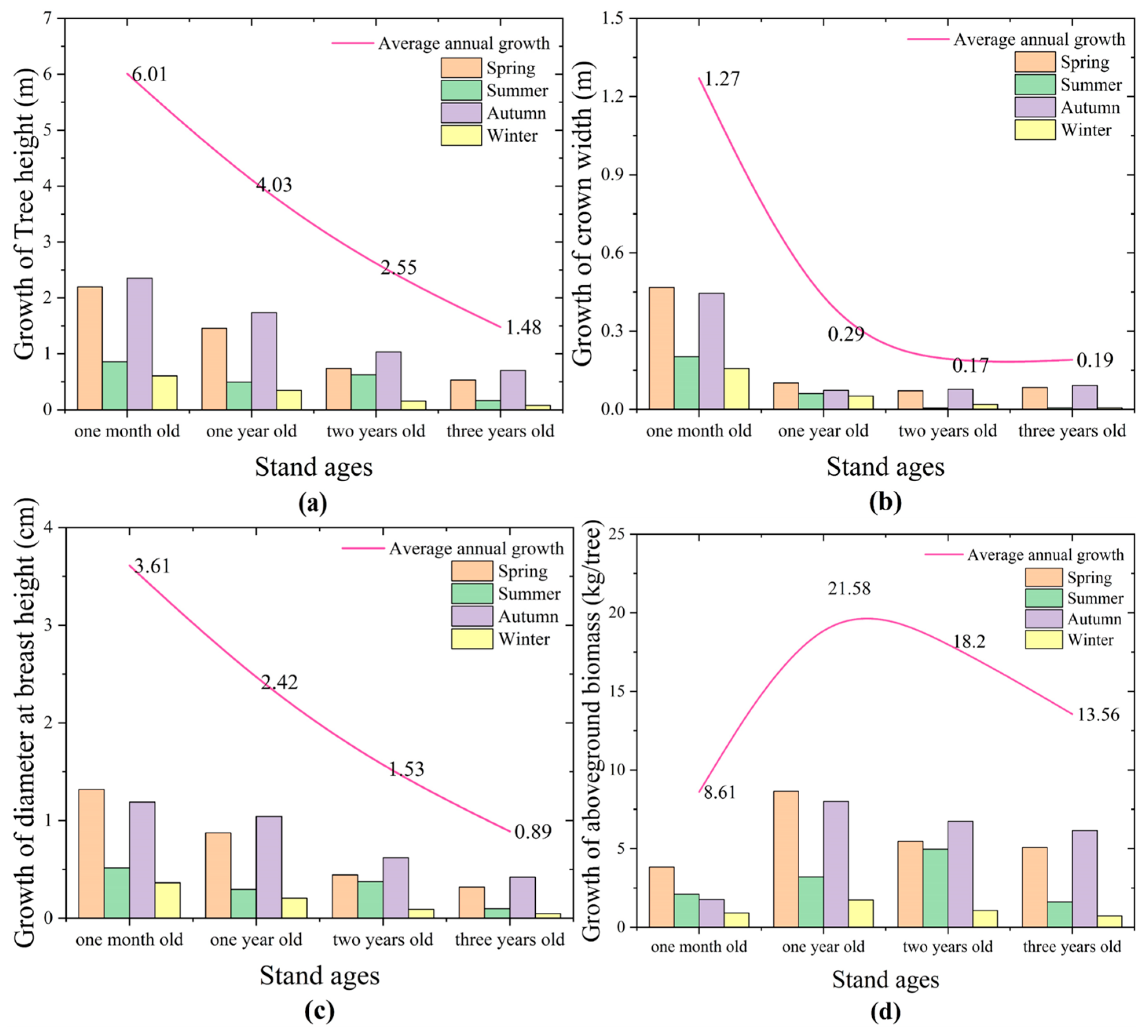
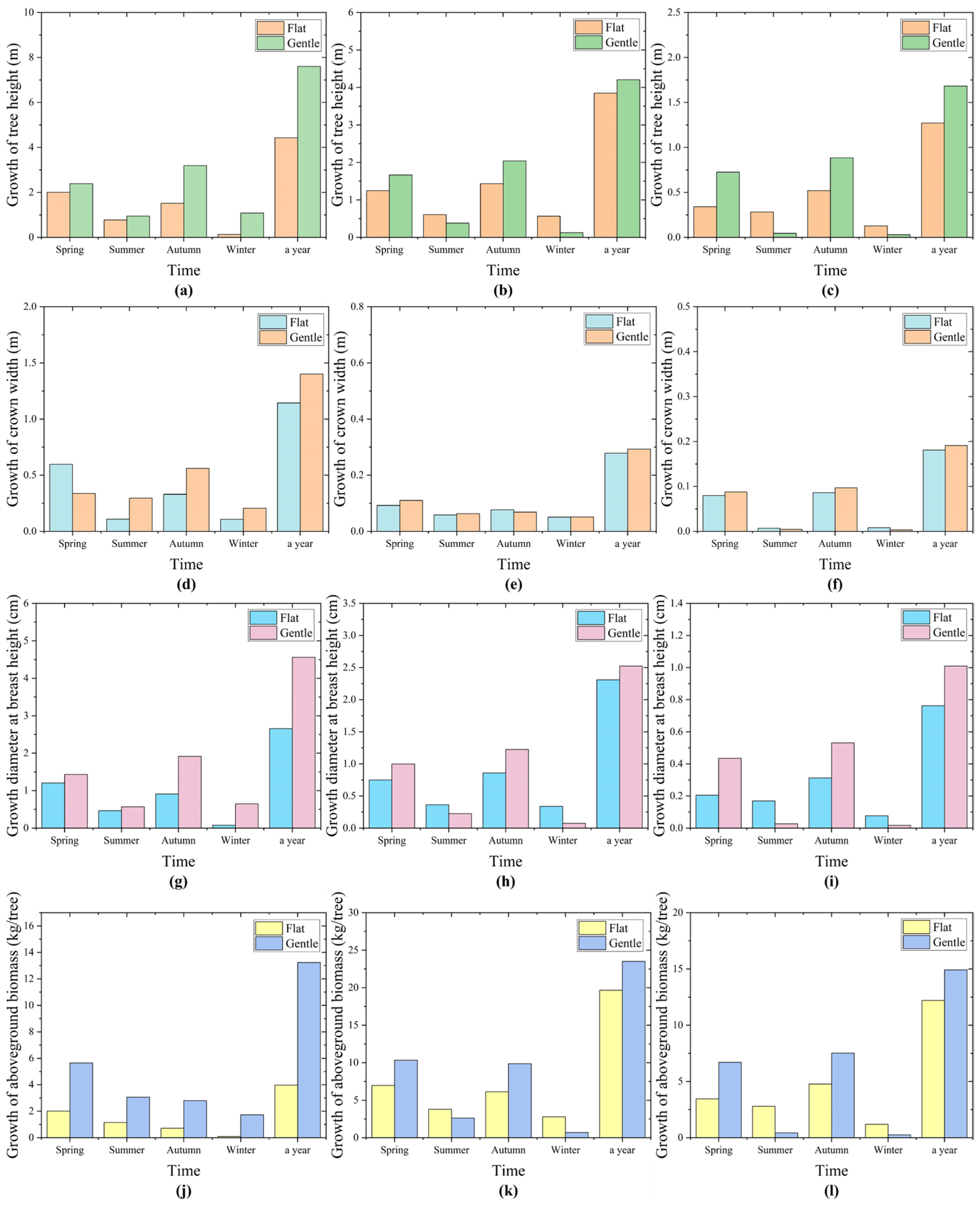
| - | TH (m) | CW (m) | DBH (cm) |
|---|---|---|---|
| Maximum | 17.98 | 2.77 | 13.8 |
| Minimum | 6.62 | 1.13 | 4.1 |
| Average | 13.71 | 2.17 | 9.4 |
| Standard deviation | 2.48 | 0.27 | 1.9 |
| Plot Number | Forest Age | Slope (°) |
|---|---|---|
| 1 | Three years old | Gentle (5–10°) |
| 2 | One year old | Gentle (5–10°) |
| 3 | One month old | Gentle (5–10°) |
| 4 | One year old | Flat (0–5°) |
| 5 | One month old | Flat (0–5°) |
| 6 | Two years old | Flat (0–5°) |
| 7 | Three years old | Flat (0–5°) |
| Plot Number | Forest Age | Quantity (Tree) | nTP | nFN | nFP | r (%) | p (%) | F (%) |
|---|---|---|---|---|---|---|---|---|
| 1 | Three years old | 85 | 80 | 5 | 0 | 94.11 | 100 | 96.97 |
| 2 | One year old | 85 | 84 | 1 | 0 | 98.82 | 100 | 99.40 |
| 3 | One month old | 85 | 83 | 2 | 0 | 97.65 | 100 | 98.81 |
| 4 | One year old | 85 | 80 | 3 | 2 | 96.39 | 97.56 | 96.97 |
| 5 | One month old | 85 | 73 | 12 | 0 | 85.88 | 100 | 92.40 |
| 6 | Two years old | 85 | 74 | 7 | 4 | 91.36 | 94.87 | 93.08 |
| 7 | Three years old | 85 | 83 | 1 | 1 | 98.81 | 98.81 | 98.81 |
Disclaimer/Publisher’s Note: The statements, opinions and data contained in all publications are solely those of the individual author(s) and contributor(s) and not of MDPI and/or the editor(s). MDPI and/or the editor(s) disclaim responsibility for any injury to people or property resulting from any ideas, methods, instructions or products referred to in the content. |
© 2023 by the authors. Licensee MDPI, Basel, Switzerland. This article is an open access article distributed under the terms and conditions of the Creative Commons Attribution (CC BY) license (https://creativecommons.org/licenses/by/4.0/).
Share and Cite
Tang, X.; Lei, P.; You, Q.; Liu, Y.; Jiang, S.; Ding, J.; Chen, J.; You, H. Monitoring Seasonal Growth of Eucalyptus Plantation under Different Forest Age and Slopes Based on Multi-Temporal UAV Stereo Images. Forests 2023, 14, 2231. https://doi.org/10.3390/f14112231
Tang X, Lei P, You Q, Liu Y, Jiang S, Ding J, Chen J, You H. Monitoring Seasonal Growth of Eucalyptus Plantation under Different Forest Age and Slopes Based on Multi-Temporal UAV Stereo Images. Forests. 2023; 14(11):2231. https://doi.org/10.3390/f14112231
Chicago/Turabian StyleTang, Xu, Peng Lei, Qixu You, Yao Liu, Shijing Jiang, Jianhua Ding, Jianjun Chen, and Haotian You. 2023. "Monitoring Seasonal Growth of Eucalyptus Plantation under Different Forest Age and Slopes Based on Multi-Temporal UAV Stereo Images" Forests 14, no. 11: 2231. https://doi.org/10.3390/f14112231
APA StyleTang, X., Lei, P., You, Q., Liu, Y., Jiang, S., Ding, J., Chen, J., & You, H. (2023). Monitoring Seasonal Growth of Eucalyptus Plantation under Different Forest Age and Slopes Based on Multi-Temporal UAV Stereo Images. Forests, 14(11), 2231. https://doi.org/10.3390/f14112231






